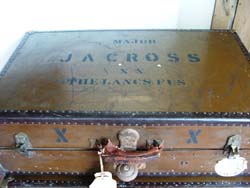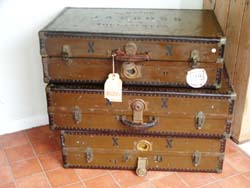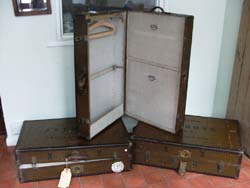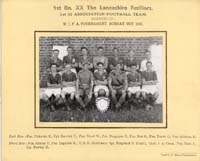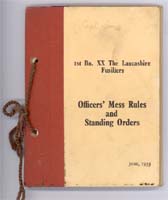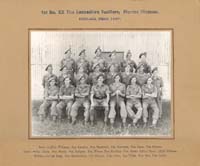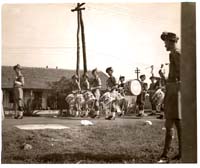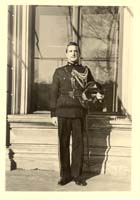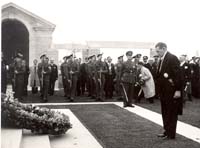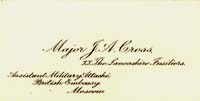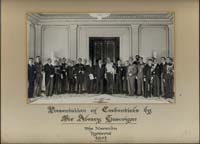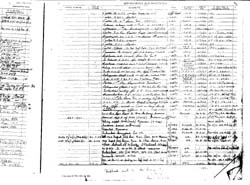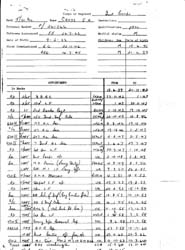of
Lt Col J A Cross
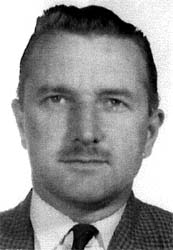
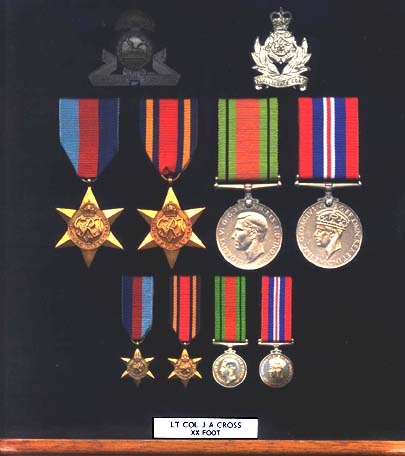
Lt Col Jack A Cross
|
In March 2010, Ray Cunningham drew my attention to an item which was for sale on Ebay. The item in question was a steamer trunk which had some interesting stencilling relating to the XX Lancashire Fusiliers and which had once been owned by a Major J A Cross of the XX. I contacted the seller and it transpired that he in fact owned three of these trunks, each beautifully stencilled in the same way. I purchased the trunks with the intention that they should be saved for later addition to the Lancashire Fusiliers Collection at the Museum in Bury. Click to enlarge |
|
I appealed for information about this Officer and had a small success when Maurice Taylor recalled that we had a LT J A Cross with the 1st Bn XX when we were the demonstration Bn at Warminster in 1948. I also found just one line in the 1958 Gallipoli Gazette which mentioned that a Major J A Cross, the 2IC of HQ Company was leaving on posting (This was when the 1st Bn were serving in Cyprus.) I could find little other evidence of his time with the XX , but Maurice had mentioned that he thought that Lt Cross had left us in 1948 to go to the Intelligence Corp. This proved to be the key to unlocking a rather fascinating story. I contacted the Military Intelligence Museum and was fortunate enough to find Major (retd) Alan Edwards. Alan proved to be very helpful and with his help I was able to piece together the Military Service history of Lt Col Cross. J A Cross was born on the 9th May 1922. |
Click on photo to enlarge it
He is next shown as General Staff Officer 3rd Grade, Army Liaison Officers 1945 to 1947. [I gleaned this from my copy of Indian Army Staff Duties in relation to GHQ India. An identical branch existed in Main HQ, 21st Army Group in Europe.]
Regimental Duty came next 1947 to 1948 ( we know from Maurice that this is when he was at Warminster with the 1st Bn.)
Lt Cross then went on a 2 year Russian Language course at Bury St Edmunds 1948 to 1950.
This was followed by his being posted to MI 10 ( now
known as GCHQ) where he spent the year 1950.
He is next to be found as Assistant Military Attache [Technical], Moscow (no doubt putting his new Russian language skills to good use.) 1951 to 1953.
Another spell of Regimental duty (Regiment not shown
) 1953 to 1955.)
The 1st Bn were in Iserlohn and the 2nd Bn were in Trieste at that time
but I can find no evidence that he was with either.
1955 to 1957 he is listed as Royal Military College of Science He was promoted Major on the 9th May 1956. (His 34th birthday )
1958 has him with the 1st Bn the XX in Cyprus (confirmed by the Gallipoli Gazette entry I mentioned earlier )
He is then shown as Deputy Assistant Director [SR], Army Operational Research Group, from 1958 to 1960. [The SR could have been one of a number of branches within AORG at the relevant time. The Army Operational Research Group existed from 1946 to 1962]
In March 1959 he joined the Intelligence Corps.
He is next listed as Officer Commanding Depot, 1960 to 1962 (Intelligence Corps Depot, Ashford, Kent)
Technical Staff Officer Grade 2 MI10 [later GCHQ]1962 to 1964.
British Military Defence Staff Washington USA 1964 to 1965 ( the cabin trunks have stickers showing all his moves abroad).
Chief Instructor, Joint Services Intelligence Wing 1965 to1968.
Held strength 1968.
Medical discharge 1969.
I have details of his last known address in 1969 and
I am now attempting to find his family to ascertain the date of his death.
AORG
In 1855 the War Office took over from the Board of Ordnance responsibility
for establishments engaged in research and development of munitions. They
were made the responsibility of the succession of Artillery and Ordnance
Departments which became the Department of the Master General of the Ordnance
in 1904. They were also of concern to the succession of Ordnance committees
and their sub-committees. During the First World War a number of new research
establishments were created, mainly under the Ministry of Munitions, which
also took over those previously under War Office control.
After the war responsibility for armaments research returned to the War
Office, together with control of its former research establishments and
several of the new ones created under the Ministry of Munitions. During
the inter-war period administration of these establishments was mostly
in the hands of the director of artillery. In 1939 it passed to the Ministry
of Supply, whence it returned in 1959 to the master general of the Ordnance
at the War Office, except for those establishments which passed to the
Ministry of Aviation.
Responsibility for research and development into chemical warfare agents
and equipment moved from the Ministry of Munitions to the War Office after
the First World War. A Chemical Warfare Research Department was established
with headquarters in London, and Chemical Defence Experimental Stations
(later Establishments) at Porton and Sutton Oak. By 1939, when responsibility
for what was now called the Chemical Defence Research Department passed
to the Ministry of Supply, its scope had extended to include biological
as well as chemical agents and equipment. In 1959 it returned to the War
Office.
The Military Operational Research Unit originated during the Second World
War within the Ministry of Supply. When this was transferred to the control
of the War Office in 1946 it was renamed the Army Operational Research
Group. Until 1954 it was concerned mostly with equipment research, but
then began work on war-gaming and other operational analysis techniques
which steadily increased in importance. It created several overseas groups
such as that with the British Army in Germany.
In January 1962 the name was changed to Army Operational Research Establishment
(AORE). Following the creation of a unified Ministry of Defence, a tri-service
operational research organisation was established: the Defence Operational
Research Establishment (DOAE) which was formed in 1965, and it absorbed
the Army Operational Research Establishment based at West Byfleet.
His son Ian Grenville Cross has achieved
great prominence.
Ian
Grenville Cross, SBS, QC, SC (born 15 June 1951) was appointed
Director of Public Prosecutions (DPP) of Hong Kong, on 15 October 1997,
and held this post for 12 years, until 21 October 2009. He was the first
DPP to be appointed after the transfer of the sovereignty of Hong Kong
to China on 1 July 1997, and the appointment was regarded as a sign that
expatriates still had a role to play in government in the post-colonial
period. A career prosecutor, Cross was the seventh holder of the post
since its creation in 1979, and the longest serving
Extra research carried out by M J Murray.
Thanks Mike.
|
Latest
Information
12/10/2011 Service in the Ranks. Jack Cross enlisted in the 5th Bn. The Suffolk Regiment (T.A.) on the 13th June 1939 and was embodied for service with that Battalion on 24th August 1939. He was promoted Corporal on 1st October 1939 and was posted to the 46th Search Light Regt with that rank as an immature (Lucky he was under age or he would have gone to Hong Kong with this unit and would have been captured by the Japanese, such is fate--Joe ) After a period of training he was employed as a Searchlight Detachment Commander and was appointed L/Sgt in December 1940.He was promoted Sergeant in July 1941 and after that date was employed as a Troop Sergeant in the U.K. until 26th May 1942. On the 10th March 1942 the CO of 46th S.L. Regt R.A. wrote, " Sgt Cross has considerable drive & personality , has a good power of command, & is very keen. I am of the opinion that he is very suitable for an Infantry Commission after training at an O.C.T.U." Jack attended the O.T.S. in India 27th May 1942 until 21st November 1942. Commissioned Service. D.L.I. & XX The Lancashire Fusiliers, Lt. 1942-44 PL Commd (10th Bn Lancashire Fusiliers). 10th Bn LF were of course then fighting in the Arakan in Burma and Jack served with them in 14 Infantry Brigade as a Platoon Commander January to May 1943. He next went to Razmak Bde N.W.F.P. Sept-Nov 1946. The Razmak Brigade was an Infantry formation of the Indian Army during World War II. It was in existence in September 1939, for service on the North West Frontier. It was normal practice for newly formed battalions to be posted to the North West Frontier for service before being sent to Africa, Burma or Italy.[1] |
Joe Eastwood and with the help of David Cross, Jack's
other son
Any writing in white is a link and by clicking on
the link it will take you to another story


